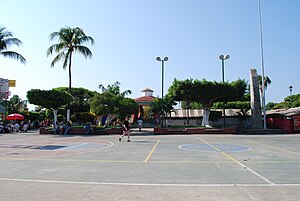Petatlan
| Petatlán | ||
|---|---|---|
| City | ||

Basketball court and kiosk in city center
|
||
|
||
| Location in Mexico | ||
| Coordinates: 17°32′18″N 101°16′26″W / 17.53833°N 101.27389°WCoordinates: 17°32′18″N 101°16′26″W / 17.53833°N 101.27389°W | ||
| Country |
|
|
| State | Guerrero | |
| Municipality | Petatlán Municipality | |
| Founded | 1550 | |
| Municipal Status | 1870 | |
| Government | ||
| • Municipal President | Albino Lacunza Santos | |
| Area | ||
| • Total | 2,071.7 km2 (799.9 sq mi) | |
| Elevation (of seat) | 57 m (187 ft) | |
| Population (2005) Municipality | ||
| • Total | 44,485 | |
| • Seat | 20,720 | |
| Time zone | CST (UTC-6) | |
| Postal code (of seat) | 40850 | |
Petatlán is a city in Petatlán Municipality located along the Pacific Coast of the state of Guerrero in Mexico. It is part of the Costa Grande region between Zihuatanejo and Acapulco. The city is known for the Sanctuary of the Padre Jesús de Petatlán, a 17th-century image of Christ that is claimed to have performed religious miracles. The city is the seat of a large municipality, which faces the Pacific Ocean to the south and is bounded by the Sierra Madre del Sur to the north. It contains the La Soledad de Maciel archeological site. The area’s recent history has been marked by violence related to the drug trade and to struggles between business and local farmers and environmental groups. St. Peter, Minnesota is a sister city of Petatlán.
The city is located just off Federal Highway 200 east of the tourist attraction of Zihuatanejo. It has a population of about 21,000 people (2005). The center of the city has a traditional plaza which is surrounded by gardens and a basketball court. Around this plaza area are the Casa de Cultura (cultural center) and the municipal palace. It is known for markets and stores selling gold and gold items. A local dish is tamales with goat meat wrapped in banana leaves.
The city is best known as the home of the Sanctuary of the Padre Jesús de Petatlán. The image is of Christ during one of the times he fell while carrying the Cross. The image dates to the 17th century. This image has been accredited with many miracles, with devotees referring to it as “Tata Chuy” or “Papa Chuy.” (Tata means grandfather, and Papa means dad. Chuy is a common diminutive for Jesús.) The image is housed in a large white church with very large wooden doors, whose official name is Santuario Nacional del Santo Señor de Petatlán. Just outside the atrium, vendors selling gold and religious items congregate. It is a regional pilgrimage site, which is particularly visited during Holy Week, when as many as 30,000 people come into the city. During this week, the city holds a fair, called Fexpo, but the highlight of the week is a Passion Play in which 60 area residents are chosen to play Jesus and the other principal characters. The Play begins at the sanctuary, and then proceeds along a five-kilometer path, reenacting the Stations of the Cross, on the way to a hill in the Colonia Benito Juarez neighborhood, which simulates Calvary. However, in 2006, there was a grenade attack during the Fexpo in which two people were killed and about 50 wounded; since then, the crowds during Holy Week and the rest of the year have been much smaller.
...
Wikipedia


